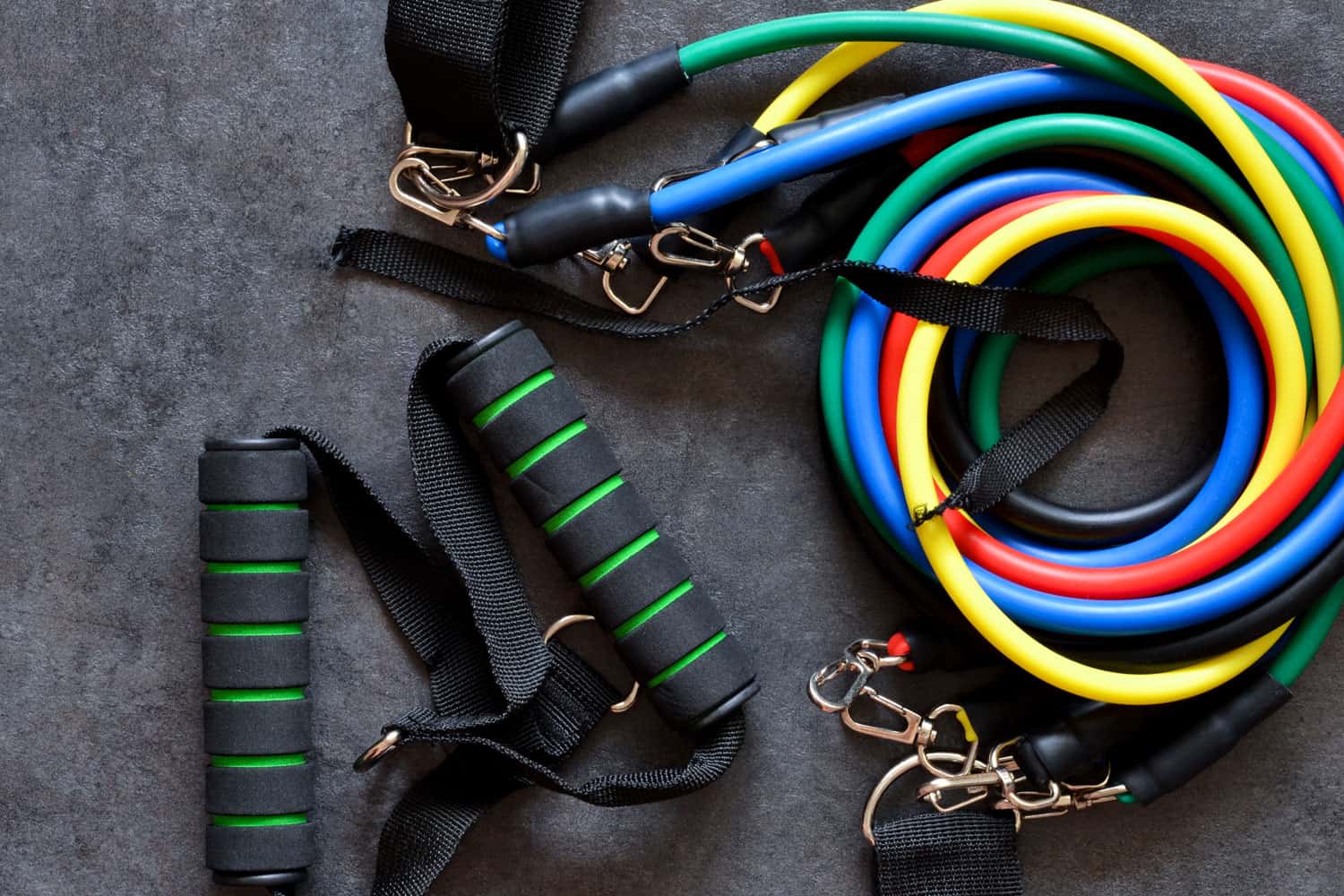Resistance bands are very convenient for home workouts or while traveling. They can sometimes be overstretched and snap, which could cause a serious injury. How far you can stretch your resistance band before it snaps? You might also wonder how to stay safe when using resistance bands and which resistance bands are the safest. We have done the research to get all of the answers to your questions.
Resistance bands can be stretched up to 2.5 times the original length. It is recommended that you do not stretch the band more than two times the length of the unstretched band for safety purposes. Resistance tubes may have anti-snap technology that makes them more challenging to break.
Now that you know how far you can safely stretch a resistance band, there are still some more helpful details to learn. This article will discuss how long resistance bands last and the signs of deterioration, how to use resistance bands safely, and the dangerous things that people do that can cause injury. Keep reading for a comprehensive discussion and answers to these questions.

How Far Can You Stretch Resistance Bands Before It Snaps?
Not all resistance bands are made equal. Flat resistance bands that are very thin are more likely to snap than tubular-shaped bands. Tube bands have anti-snap technology and also encase the material that would snap, which protects you in the rare event that it would snap.
In general, resistance bands can be stretched to 2.5 times the length of the unstretched band. While 2.5 times is considered okay, it is recommended to only stretch up to 2 times the length of the unstretched band for safety purposes.
You can protect yourself and help your resistance bands have a longer lifespan by using the bands correctly. Different types of resistance bands can be used for various exercises. Think about how you want to use resistance bands for your workout or physical therapy.
Learn more about the different types of resistance bands by checking out this article: 5 Types Of Resistance Bands To Know
Click here to check out this Allvodes Exercise Band Set (5-Piece) from Amazon.
How Long Do Resistance Bands Last?
Resistance bands lose their resistance over time in the way a rubber band loses elasticity when stretched frequently. If you use your resistance bands twice per week, you may expect to see them last six months to a year.
This is the standard for flat resistance bands. Tube resistance bands are more durable, contain anti-snap technology, and are likely to last longer.

If your resistance bands sit in the corner for a year, then they will not lose their elasticity. The lifespan of resistance bands depends on the brand you choose and the amount you use them. There are steps you can take to make your resistance bands last longer.
- Store your bands in a cool, dry place.
- Keep bands out of extreme temperatures or sunlight.
- Stack multiple resistance bands and use them together. When you stack numerous resistance bands together, you reduce the amount of strain each band has to endure.
- Avoid using chemicals or soap to clean the bands. This will cause faster deterioration. Instead, use a damp cloth to clean your resistance bands.
- Use thicker resistance bands or tubes. The thicker tubes are stronger and usually have a longer lifespan.
When Should I Replace My Resistance Bands?
When you should replace your bands depends on how you use the bands, how often you use them, and whether or not you see signs of wear. Physical therapists are expected to replace resistance bands after just a month or two. People using bands for home workouts two times a week might replace them after a year or when there are signs of wear.
Not all resistance bands have handles, but the handle is usually the first place where the resistance band will wear or tear. Look at the attachments from the handles to the resistance bands. Make sure there are no rips, tears, or bent metal pieces.
Look for any areas of the resistance band that are discolored or marked. This is an indication that a part of the band has been over-stretched or pinched. When you see any of these signs of wear and tear, you should replace your resistance bands.
How Tight Should Resistance Bands Be?
You should be able to do a resistance exercise with 10-15 reps. If you can do more than 15 reps, then the resistance band isn't tight enough. If you aren't able to do ten reps, then the resistance band is too tight.
The goal is to keep your muscles under tension for the duration of your reps and not losing that tension between reps. This is one benefit of resistance bands as they provide even tension throughout the reps better than free weights.
Tribe Resistance Bands Set
Click here to buy Tribe Resistance Bands Set from Amazon.
Can You Double Up Resistance Bands?
You can double up or "stack" resistance bands to increase the weight of your reps. Several resistance band sets on the market allow you to add and remove different-colored bands to meet your 10-15 rep goal. Each resistance band is given a per pound measure of resistance.
Each of the bands is connected to the handles, which increases the overall resistance and difficulty of the exercise. This also helps to reduce the amount of strain on each resistance band, which will ensure a greater lifespan for all of your bands.

What Should You Not Do With Resistance Bands?
Resistance bands are elastic like rubber bands. Just like rubber bands, they can snap if put under enough pressure or stretched too far. They can also snap back and cause serious injury if proper precautions aren't taken. Here are the things you should not do with resistance bands.
- Don't stretch the resistance band more than 2.5 times the unstretched length.
- Don't place the handles over your feet. This is not a secure grip. It could easily slip off your foot, snap back, and cause a serious injury.
- Don't jerk the band. Nice slow reps are better for exercise and also safer to ensure the integrity of the band.
- Don't release a band that is under pressure.
- Don't use resistance bands that show signs of wear. Regularly inspect the bands for wear and tear.
- Don't use bands on uneven surfaces.
- Don't use resistance bands for any unintended use. They are not toys and should only be used for exercise and physical therapy.
- Don't anchor your resistance band on sharp or rough surfaces that may cause damage to the bands.
What Should I Use For An Anchor?
You want to make sure you are properly anchoring your resistance bands against a smooth surface, or they might become damaged. Resistance band sets come with an anchor that can be used with a closed door. Don't use the anchor on a door that another family member might open while working out. Otherwise, make sure you lock the door during your exercise.
OUUO Heavy Duty Door Anchor Attachment
Click here to check out the OUUO Heavy Duty Door Anchor Attachment on Amazon.
In Closing
Resistance bands can be stretched safely to 2.5 times the unstretched length of the band. In some cases, they can be stretched up to 3 times the length. You can choose thicker resistance tubes that are stronger. You can stack these resistance tubes to reduce the strain on each band. If safety is a concern, then you can make sure to stretch the resistance band to only twice the length.
For more information on how to use resistance bands in your workout, check out these posts.




![Read more about the article How Many Frames Are In A Game Of Bowling? [And How Long It Lasts]](https://fitseer.com/wp-content/uploads/2022/04/An-orange-bowling-ball-rolling-to-the-bowling-pins-500x333.jpg)

![Read more about the article Do Basketball Shoes Make You Taller? [The answer may surprise you!]](https://fitseer.com/wp-content/uploads/2020/10/A-pair-of-basketball-shoes-on-a-court-next-to-a-basketball-500x333.jpg)

![Read more about the article What Are The Best Socks For Pilates? [7 Suggestions]](https://fitseer.com/wp-content/uploads/2020/10/Woman-stretching-her-legs-and-limbs-on-a-yoga-mat-before-starting-stretching-500x333.jpg)
